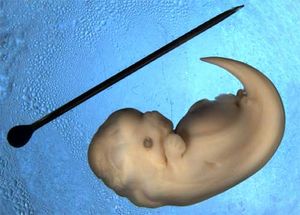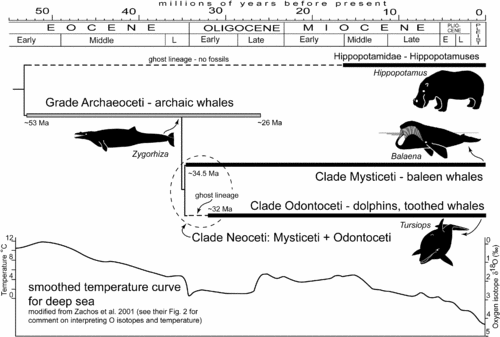Evolution of cetaceans
The cetaceans (whales, dolphins and porpoises) are descendants of land-living mammals, and remnants of their terrestrial origins can be found in the fact that they must breathe air from the surface; in the bones of their fins, which look like huge, jointed hands; and in the vertical movement of their spines, characteristic more of a running mammal than of the horizontal movement of fish. The question of how land animals evolved into ocean-going behemoths has been a mystery for a long time, owing to gaps in the fossil record. However, recent discoveries in Pakistan have managed to solve many of these mysteries, and it is now possible to see several stages in the transition of the cetaceans from land to sea.
Earliest ancestors
The traditional theory of cetacean evolution was that whales were related to the mesonychids, an extinct order of carnivorous ungulates (hoofed animals), which looked rather like wolves with hooves and were a sister group of artiodactyls. These animals possessed unusual triangular teeth that are similar to those of whales. For this reason, scientists had long believed that whales evolved from a form of mesonychid.
However, since the early 1990s analysis of a wide variety of protein and DNA sequence data consistently indicated that whales should be included among artiodactyls. Most probably they are a sister group of hippopotamids, deeply buried within artiodactyls. The strong evidence for a clade combining cetaceans and artiodactyls is further discussed under the entry Cetartiodactyla.
The recent discovery of Pakicetus, the earliest proto-whale (see below) supports the molecular data. The skeletons of Pakicetus demonstrate that whales did not derive directly from mesonychids. Instead, they are a form of artiodactyl (another type of ungulate) that began to take to the water after the artiodactyl family split from the mesonychids. In other words, the proto-whales were early artiodactyls that retained aspects of their mesonychid ancestry (such as the triangular teeth) which modern artiodactyls have since lost. An interesting implication is that the earliest ancestors of all hoofed mammals were probably at least partly carnivorous or scavengers, today's artiodactyls and perissodactyls having switched to a plant diet later in their evolution. Whales, due to the readier availability of animal prey and their need for higher caloric content to live as marine endotherms, naturally retained their carnivorous diet, as did mesonychids, who were however out-competed by better-adapted animals like the Carnivora later on (mesonychids became specialized carnivores when the overall availability of large animal prey was still low; thus their adaptation was likely at a disadvantage when new forms had filled the gaps left by the dinosaurs).
Thewissen more recently report finding an artiodactyl, the Eocene south Asian raoellid artiodactyl, with greater similarity to whales, including a partially aquatic lifestyle:[1]
Although the first ten million years of whale evolution are documented by a remarkable series of fossil skeletons, the link to the ancestor of cetaceans has been missing. It was known that whales are related to even-toed ungulates (artiodactyls), but until now no artiodactyls were morphologically close to early whales. Here we show that the Eocene south Asian raoellid artiodactyls are the sister group to whales. The raoellid Indohyus is similar to whales, and unlike other artiodactyls, in the structure of its ears and premolars, in the density of its limb bones and in the stable-oxygen-isotope composition of its teeth. We also show that a major dietary change occurred during the transition from artiodactyls to whales and that raoellids were aquatic waders. This indicates that aquatic life in this lineage occurred before the origin of the order Cetacea.
Pakicetids: the earliest Cetaceans?
The pakicetids are hoofed-mammals that are sometimes classified as the earliest whales.[2] They lived in the early Eocene, around 52 million years ago. They looked rather like dogs with hoofed feet and long, thick tails. They have been linked to whales by their ears: the structure of the auditory bulla is formed from the ectotympanic bone only, a feature shared by modern whales. It was initially thought that the ears of Pakicetus were adapted for underwater hearing, but, as would be expected from the anatomy of the rest of this creature, the ears of Pakicetus are specialized for hearing on land, and if Pakicetus is related to the ancestors of whales, underwater hearing must have been a later adaptation.[3] According to Thewissen, the teeth of Pakicetus also resemble the teeth of fossil whales, which is another link to more modern whales.[4]
Ambulocetids and remingtonocetids
The most remarkable of the recent discoveries in Pakistan has been Ambulocetus, which looked like a three-metre long mammalian crocodile. Ambulocetus was clearly amphibious, as its back legs are better adapted for swimming than for walking on land, and it probably swam by undulating its back vertically, as otters, seals and whales do. It has been speculated that Ambulocetids hunted like crocodiles, lurking in the shallows to snatch unsuspecting prey.
A smaller cousin of Ambulocetus was the remingtonocetid family, which had longer snouts than Ambulocetus', and were slightly better adapted for underwater life. It has been speculated that they lived like modern sea otters, hunting for fish in the shallows.
Protocetids
The protocetids form a diverse and heterogeneous group known from Asia, Europe, Africa, and North America. There were many genera, and some of these are very well known (e.g., Rodhocetus). Known protocetids had large fore- and hindlimbs that could support the body on land, and it is likely that they lived amphibiously: in the sea and on land. It is unclear at present whether protocetids had flukes (the horizontal tail fin of modern cetaceans).
Basilosaurids and dorudontids: fully marine cetaceans
Basilosaurus (discovered in 1840 and initially mistaken for a lizard, whence its name) and Dorudon lived around 38 million years ago, and were fully recognisable whales which lived entirely in the ocean. Basilosaurus was a monstrous creature, up to 18m long; dorudontids were within the range of modern cetacean size, about 5m long. Although they look very much like modern whales, basilosaurids and dorudontids lacked the 'melon organ' that allows their descendants to sing and use ultrasound as effectively as modern whales. They had small brains; this suggests they were solitary and did not have the complex social structure of modern whales. Basilosaurus had two tiny but well-formed hind legs which were probably used as claspers when mating; they are a small reminder of the lives of their ancestors.
Early Echolocation
Toothed whales (Odontocetes) echolocate by creating a series of clicks emitted at various frequencies. Sound pulses are emitted through their melon-shaped forehead, reflected off objects, and retrieved through the lower jaw. Skulls of Squalodon show evidence for the first appearance of echolocation. Squalodons lived from the early to middle Oligocene to the middle Miocene, around 33-14 million years ago. A peculiar blend of archaic and modern features characterize Squalodon. The cranium was well compressed, the rostrum telescoped outward, giving an appearance of modern toothed whales. However, it is thought unlikely that squalodontids have anything to do with the ancestry of most living dolphins.
Early Baleen Whale
All modern mysticetes are large filter-feeding or Baleen whale, though the exact means by which baleen are used differ among species (gulp-feeding with balaenopterids, skim-feeding with balaenids, and bottom ploughing with eschrichtiids). The first members of some modern groups appeared during the middle Miocene. These changes may have been a result of worldwide environmental change and physical changes in the oceans. A large scale change in ocean current and temperature could have initiated the radiation of modern mysticetes, leading to the demise of the archaic forms. Generally it is thought the four modern mysticete families have separate origins among the cetotheres, however this is only speculative. Modern baleen whales, [Balaenopteridae (rorquals and humpback whale, Megaptera novaengliae), Balaendia (right whales), Eschrichtiidae (gray whale, Eschrictius robustus), and Neobalaenidae (pygmy right whale, Caperea marginata) all have derived characteristics presently unknown in any cetothere.
Early Dolphins

During the early Miocene, echolocation developed in its modern form. Various extinct dolphin-like families flourished. Early dolphins include Kentriodon and Hadrodelphis. These belong to Kentriodontidae, which were small to medium-sized toothed cetaceans with largely symmetrical skulls, and thought likely to include ancestors of some modern species. Kentriodontids date to the late Oligocene to late Miocene. Kentriodontines ate small fish and other nectonic organisms; they are thought to have been active echolocators, and might have formed schools. Diversity, morphology and distribution of fossils appear parallel to some modern species.
Modern whales
Today, the whale hind parts are internal and reduced, and they serve as anchor for the muscles of the genitalia. Occasionally, the genes that code for longer extremities cause a modern whale to develop miniature legs (known as atavism). Whereas early cetaceans such as the Pakicetus had the nasal openings at the end of the snout, in later species such as the Rodhocetus, the openings had begun to drift toward the top of the skull. This is known as nasal drift. Instead of nostrils, modern whales have blowholes that allow them to break to the surface, inhale, and submerge with convenience. The ears began to move inward as well, and, in the case of Basilosaurus, the middle ears began to receive vibrations from the lower jaw. Today's modern toothed whales use the 'melon organ', a pad of fat, for echolocation.
References
- ↑ Whales originated from aquatic artiodactyls in the Eocene epoch of India. Nature 450, 1190-1194 (20 December 2007). J. G. M. Thewissen, Lisa Noelle Cooper, Mark T. Clementz, Sunil Bajpai & B. N. Tiwari
- Abstract: Although the first ten million years of whale evolution are documented by a remarkable series of fossil skeletons, the link to the ancestor of cetaceans has been missing. It was known that whales are related to even-toed ungulates (artiodactyls), but until now no artiodactyls were morphologically close to early whales. Here we show that the Eocene south Asian raoellid artiodactyls are the sister group to whales. The raoellid Indohyus is similar to whales, and unlike other artiodactyls, in the structure of its ears and premolars, in the density of its limb bones and in the stable-oxygen-isotope composition of its teeth. We also show that a major dietary change occurred during the transition from artiodactyls to whales and that raoellids were aquatic waders. This indicates that aquatic life in this lineage occurred before the origin of the order Cetacea.
- First paragraph of paper: Phylogenetic analyses of molecular data on extant animals strongly support the notion that hippopotamids are the closest relatives of cetaceans (whales, dolphins and porpoises). In spite of this, it is unlikely that the two groups are closely related when extant and extinct artiodactyls are analysed, for the simple reason that cetaceans originated about 50 million years (Myr) ago in south Asia, whereas the family Hippopotamidae is only 15 Myr old, and the first hippopotamids to be recorded in Asia are only 6 Myr old. However, analyses of fossil clades have not resolved the issue of cetacean relations. Proposed sister groups ranged from the entire artiodactyl order, to the extinct early ungulates mesonychians7, to an anthracotheroid clade8 (which included hippopotamids), to weakly supporting hippopotamids (to the exclusion of anthracotheres).
- ↑ P. D. Gingerich & D. E. Russell (1981). "Pakicetus inachus, a new archaeocete (Mammalia, Cetacea) from the early-middle Eocene Kuldana Formation of Kohat (Pakistan)". Univ. Mich. Contr. Mus. Paleont 25: 235–246.
- ↑ J. G. M. Thewissen, E. M. Williams, L. J. Roe and S. T. Hussain (2001). "Skeletons of terrestrial cetaceans and the relationship of whales to artiodactyls". Nature 413: 277–281.
- ↑ Whale Origins
- Pakicetus inachus, a new archaeocete (Mammalia, Cetacea) from the early-middle Eocene Kuldana Formation of Kohat (Pakistan). Gingerich, P.D., 1981, Museum of Paleontology, The University of Michigan
- Skeletons of terrestrial cetaceans and the relationship of whales to artiodactyls, Nature 413, 277-281 (20 September 2001), J. G. M. Thewissen, E. M. Williams, L. J. Roe and S. T. Hussain
- Evolution of Whales Adapted from National Geographic, November 2001, Revised 2006 Dr. J.G.M. Thewissen
